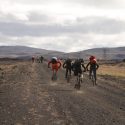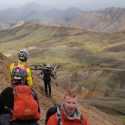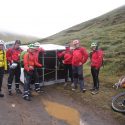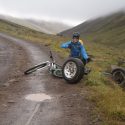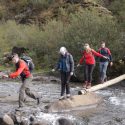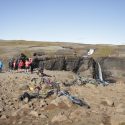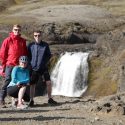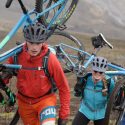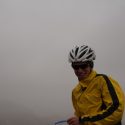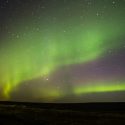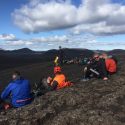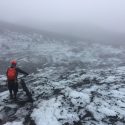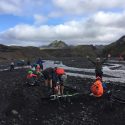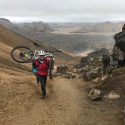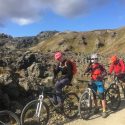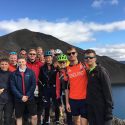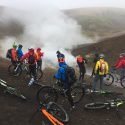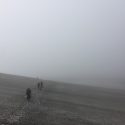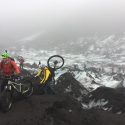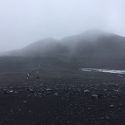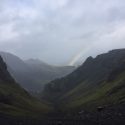Introduction
Northumbrian University Air Squadron recently embarked on Exercise Icelandic Traverse – a two week expedition in which students would cycle from the north coast to the south coast of Iceland.The expedition began with squadron members meeting at RAF Leeming on 26th August 2019. Here, mountain bikes were checked and prepared, kit was issued and initial briefs were delivered. On the 28th of August, the group left RAF Leeming for Manchester International Airport bound to Keflavik. On arrival, students re-assembled their bikes while support vehicles, a Land Rover Super Defender and trailer were collected. The group then travelled to Akuoyri where the night was spent in a hostel, ready to depart on the bikes early the next morning.
Day 1 – Akureyri to wild camp
We set off from Akureyri at 0900, and with a strong tailwind behind us embarked on the first stage of our 350Km ride to Skogar. We made quick progress, but also experienced our first difficulties which came with cycling in such a large group. Firstly, the front started separating from the back which meant that when the rear pack arrived at a stopping point, they would get less time to rest. This was identified quickly and a manageable pace was set at the front to keep us as one team. The second difficulty we experienced was the weather, the problem of which was exacerbated by the fact that many students had underestimated how quickly things could change, especially at altitude and were subsequently not properly equipped. Nonetheless, we made quick progress and make quick progress as the asphalt turned into gravel tracks. As we were approaching the end of the ride, word got to us that there was a technical issue with trailer and that the support vehicle would be late to the wild camp. With this in mind, the group pressed on, adding more distance on what was already a long day in the hope of passing some challenging peaks and completing the first river crossing whilst we waited for the support. Although at the time everybody agreed this was the correct decision, with hindsight a few students admitted that they were more tired then they were willing to admit to the team. When this was discussed during a team meeting later in the trip, a scale was devised from 1 to 10 as to more honestly determine the condition of the team in future situations. Shortly after making the decision to continue, word reached us that the trailer had been substantially damaged and that we would rendezvous back at the vehicle and set up camp while the situation was assessed. The support staff travelled back to Akureyri to solve the issue with the trailer, whist NUAS quickly set up camp and awaited news.
Day 2 – Wild camp back to Akureyri
The following morning word reached us that we would have to return to Akureyri – without a support vehicle, progressing would not be possible. Although this news was naturally disappointing for everyone, we appreciated that this was an issue out of our control and we did not let it dent moral. With a strong headwind, the 50km back to Akureyri was a long ride. We utilised a peloton to minimise the effect of the headwind, students taking it in turns to face the wind at the front whilst others settled in the slipstream behind which improved our progress. We arrived back into Akureyri in the pouring rain to finish what was a difficult day. Back at the hostel, the mood quickly improved. The team was very much appreciative of the circumstances; what we had come to do wasn’t easy nor was the landscape that both we and the support staff had to navigate. It is part in parcel of what makes adventurous training adventurous, and we knew that we would be back on track soon.
Day 3 – Journey back to Reykjavik
On day 3 we had a long drive back to Reykjavik to get a new support trailer to continue the expedition. This was frustrating but the time was used effectively – students allocated jobs amongst themselves to make best use of the time. This included seeking out activities to do over the next two days; days in which we would have free while we waited for a replacement support vehicle. On arrival to the hostel, the options discussed on the journey were deliberated and what we were going to do over the next two days were decided. This included a hike to Glymur falls and a challenging mountain bike trail.
Day 4 – Glymur falls hike
At 1000 we departed for our hike around Glymur falls; the second tallest waterfall in Iceland. Weather was great and the hike presented challenges such as crossing a river on a log and some steep climbs on loose terrain. The view from the top was incredible and we sat in full view of the waterfall to have lunch. We used the opportunity to get our drone airborne to take some fantastic group photos. The day was very much appreciated by all of us; it involved good planning from students at short notice. After being in transit all day the day before it was great to get back doing some adventurous training.
Day 5 – Haifoss – Stong Loop
At 0900 we set off to Haifoss to get back on the mountain bikes. We used one of our instructors previous knowledge of Iceland to put in place an exciting, challenging loop up to a waterfall followed by challenging, technical single track on the way down. It was our first glimpse of single track on the trip; fast and winding, it required a lot of concentration but was arguably the most enjoyable riding we had done. We were taught riding techniques such as the ‘ready position’ and defensive riding techniques. Although this day was not on the original agenda, it ended up being an extremely valuable day in which we not only learned a lot, but had a lot of fun. After the ride we packed the bikes into the back of the trailer and went onto the Highland Centre, where we would be spending that evening.
We used that evening to have a group assessment of how the expedition had gone so far; what had we learned? What training values had we covered? What had we done well? How could we improve? It was important we identified these points, as we knew the expedition was going to become more difficult from here on out. Later that night we shared a special moment as a team as we all gathered outside in the emptiness of Iceland to observe the extraordinary Northern Lights.
Day 6 – Highland Centre to Landmannalauger
Although we had been cycling the previous day, we were keen to get back on route. We passed stunning volcanic scenery on flat, dry and dusty tracks on our way to Landmannalauger on what was a clear day. We stopped at a volcano crater turned lake to take in the stunning scenery and have lunch before arrival. On arrival to Landmannalauger it didn’t take us long to discover the hot spring nearby and quickly occupy it! It was fantastic to experience the volcanic hot springs; a phenomenon inclusive to Iceland and something many think of when they think of Iceland. It was an excellent moral for us to be able to rest and recuperate as one team in such an environment almost exclusive to this part of the world.
Day 7 – Landmannalaugar – Skalli Loop
We were ready at 0900 for what we knew would be a challenging start with a bike and hike through 400m of ascent. This was our first opportunity carrying our bikes at steeper terrain; we were taught several carrying techniques which could be used in several situations, namely for short and long distances . It showed us what we could expect in the days ahead, and not to be complacent. Weather was not on our side; with temperatures hovering around zero, poor visibility and high winds combing for tough conditions. Students wearing lightweight sports trainers we immediately made aware of the lack of grip in these conditions. It was strongly encouraged to wear footwear more tailored for hiking for the coming days where we knew we would be facing a lot of hike a bike segments.
Day 7 – Landmannalaugar to Alftavatn Hut
This ride would prove to be our most challenging yet; a big mountain ride with elevation gain upwards of 2300 feet. The route entailed a lot of up and down including long segments of ‘hike and bike’. Everyone worked hard on what was our most physically demanding day yet. Lessons learned from previous day with students a lot better equipped to deal with the elements on what was an extremely cold, wet and windy day in low visibility conditions.
Day 8 – Alftavatn Hut to Porsmork Volcano Huts
2 Mechanical failures and 3 crashes which happened near the end of the day. This highlighted the need for due diligence on long rides where concentration can easily lapse and mistakes can be made due to complacency at the fact we were nearly finished for the day. We also encountered deep river crossings with strong currents; the glacial meltwater certainly wasn’t warm!
Day 9 – Porsmork Volcano Huts to Skogarfoss
They say you save the best until last, and indeed were we in for a special day. We crossed glaciers, volcanoes and waterfalls in rain, hail, sun and wind on what would turn out to be the slowest 20 miles of the trip. Throughout the day we tackled huge sections of hiking and biking; steep gorges both up and down meant a lot of stopping and starting taking bikes on and off our backs. Iceland threw everything it had at us; the day starting with a straight climb up Thórsmörk mountain ridge, 3000 feet on narrow tracks with treacherous drops as the weather started to turn against us. From great peaks we moved on to bleak, extensive lava fields and icy treacherous glaciers at Eyjafjallajökull. Although this section was arguably the most difficult of the expedition, cycling across this alien landscape was an experience none of us will forget. The glacier was particularly difficult to cross, rain making the ice particularly slippery. There was some respite on the other side as we rested in a mountain hut to compose ourselves for the final, downhill segment. We were rewarded with an exciting, fast descent all the way into Skogar. We passed Skogafoss waterfall as we were met at the bottom by our support staff; our epic journey across Iceland was complete.
What was the highlight of the trip?
With so many memorable moments, it’s hard to pick a ‘highlight’. In terms of cycling, most agreed the last day on the bikes from the Volcano Huts to Skogar was the highlight. The ride was long in distance, high in climbs and finished with fast single track; all this across mountains, glaciers and lava fields.
We shared so many moments as a team to remember off the bikes too, especially relaxing in natural hot springs and stargazing at the Northern Lights. These experiences would not have been possible without travelling to country as geographically diverse as Iceland is. It threw at us every challenge, and we took everyone with dogged determination as a team.
What was the low point of the trip?
This point, for most of us, came when we found out that we would be retreating back to Akureyri. For an expedition so long in the making to be compromised so soon for something out of our control was demoralising.
Yet, they say ‘everything happens for a reason’ and this, amongst many of us perfectly reflects the outcome that situation had on our expedition.
When the trailer broke, it required joint decision making from the team on what to do. It brought out the best of NUAS in a bad situation. Camping that night in a damp valley may have brought many people down, but we seized the opportunity to bond even more as a team. Moreover, the hike to Glymur Falls and Haifoss – Stong loop were personal highlights for many of us and arguably gave us more value than two days of cycling across flat terrain would have given us. Most importantly, regardless of where we found ourselves we never wasted a moment of time; rather than commiserate we adapted,and overcame it.
Overall impact
Icelandic Traverse gave NUAS the opportunity to complete a truly challenging, once in a lifetime experience. The challenges were not limited to the obvious physical stamina needed to complete such a feat, but tested students mental resilience too; from bitterly cold crosswinds and river crossings, to days on which the ride seemed endless.The expedition further impacted students’ abilities in areas such as navigation and riding techniques, but also impacted in areas one might not have expected. The expedition gave us an appreciation of the environment; we were made aware of the impacts of erosion and the importance of staying on the track. As mentioned previously, the expedition experienced low points but in hindsight it was these low points which arguably had the greatest impact. The big climbs, bitter cold and tired legs all served to improve students’ fitness, resilience and esprit de corps.
Off Cdt Meacher on how the expedition impacted him:
“I obviously I learnt more about mountain biking and expedition prep, but more importantly, I learnt how to cope in a team of 16 for two weeks with very little down time. It’s natural for patience to wear thin after long, exhausting days, but as a team we learnt how to be mindful of one another. Also, I learnt to be wary of off-roading with trailers…”
Finally, the expedition showed what kind of experiences are available to the University Air Squadron, especially with the support of the Ulysses Trust. With ambition, commitment and organisation from student’s almost anything can be achieved, and Icelandic Traverse shows that. The resounding success of the expedition will only serve to prove this point for our future endeavours and sew further ambition into an already ambitious NUAS.

